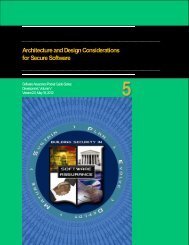SwA in Education, Training & Certification - US-Cert
SwA in Education, Training & Certification - US-Cert
SwA in Education, Training & Certification - US-Cert
Create successful ePaper yourself
Turn your PDF publications into a flip-book with our unique Google optimized e-Paper software.
» Software Assurance Eng<strong>in</strong>eer<br />
» Provide technical leadership <strong>in</strong> all aspects of software assurance and computer systems eng<strong>in</strong>eer<strong>in</strong>g<br />
support.<br />
» Lead and actively participate <strong>in</strong> the evaluation and analyses of activities related to all phases of the<br />
secure software life cycle from <strong>in</strong>itial plann<strong>in</strong>g, requirements def<strong>in</strong>ition, design and development through<br />
<strong>in</strong>tegrated system test<strong>in</strong>g and susta<strong>in</strong><strong>in</strong>g operations.<br />
» Responsibilities will also <strong>in</strong>clude the support of a wide range of technical and programmatic activities for<br />
program offices, <strong>in</strong>clud<strong>in</strong>g lead<strong>in</strong>g the review and assessment of software system architecture; system<br />
requirements and their allocation to lower level specifications; design, code and test activities; trade<br />
studies; COTS/GOTS products; reuse software; test tools; simulators; software verification and<br />
validation (V&V); and system test and <strong>in</strong>tegration. Support <strong>in</strong>dependent review efforts <strong>in</strong> analyz<strong>in</strong>g and<br />
assess<strong>in</strong>g system software and related development and test<strong>in</strong>g activities.<br />
» Information Security Systems & Software Development Professional (ISSSDP)<br />
» The Information Security Systems and Software Development Professional is responsible for secure<br />
design, development, test<strong>in</strong>g, <strong>in</strong>tegration, implementation, susta<strong>in</strong>ment, and/or documentation of<br />
software applications (web based and non-web) follow<strong>in</strong>g formal secure systems development lifecycle<br />
processes and us<strong>in</strong>g security eng<strong>in</strong>eer<strong>in</strong>g pr<strong>in</strong>ciples.<br />
» The follow<strong>in</strong>g professional requirements form part of a broad Federal Government effort to identify and<br />
describe roles.<br />
» I: Entry level:<br />
� Basic understand<strong>in</strong>g of computer systems and related <strong>in</strong>formation security software and hardware<br />
components, network systems and databases, and <strong>in</strong>formation systems security safeguards<br />
� Capable of articulat<strong>in</strong>g software/system abuse and misuse cases; understands practices and tools<br />
for mitigat<strong>in</strong>g exploitable software weaknesses<br />
� Writes code <strong>in</strong> different programm<strong>in</strong>g languages (e.g., Java, C, C++)<br />
� Integrates off-the-shelf products with <strong>in</strong>formation assurance safeguards (e.g., implement<strong>in</strong>g<br />
network firewalls and routers)<br />
� Participates <strong>in</strong> small teams perform<strong>in</strong>g software development and <strong>in</strong>formation security softwareoriented<br />
tasks<br />
» II: Intermediate level:<br />
� Advanced understand<strong>in</strong>g of <strong>in</strong>formation systems security, ethical hack<strong>in</strong>g, multiple network<br />
analysis, configuration management, <strong>in</strong>tegration and deployment issues<br />
� Designs secure software systems from requirements with<strong>in</strong> the software development lifecycle;<br />
derives additional security requirements based on the deployment environment<br />
� Communicates technical <strong>in</strong>formation to non-technical audiences and advises staff on <strong>in</strong>formation<br />
security issues and approaches<br />
� Applies knowledge of <strong>in</strong>formation security aspects (e.g., cod<strong>in</strong>g, operat<strong>in</strong>g systems, programm<strong>in</strong>g<br />
languages, databases, federal and agency policies and procedures)<br />
� Performs static and dynamic analysis to identify vulnerabilities <strong>in</strong> applications, across databases,<br />
networks, network-based environments, and operat<strong>in</strong>g systems, and directs remediation as<br />
appropriate<br />
� Creates protocols, procedures, and guidel<strong>in</strong>es to mitigate security risks<br />
» III: Advanced level:<br />
� Expert understand<strong>in</strong>g of <strong>in</strong>formation systems security, ethical hack<strong>in</strong>g, multiple network analysis,<br />
configuration management, <strong>in</strong>tegration and deployment issues<br />
� Serves as senior advisor to the architectural design and development of enterprise-wide<br />
applications, systems, and services<br />
Software Assurance Pocket Guide Series:<br />
Life Cycle Support, Volume I – Version 2.2, Mar 16, 2011<br />
Software Assurance <strong>in</strong> <strong>Education</strong>, Tra<strong>in</strong><strong>in</strong>g & <strong><strong>Cert</strong>ification</strong><br />
18

















